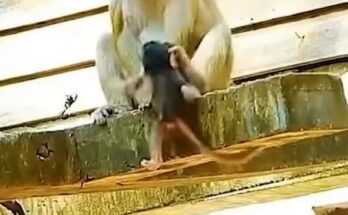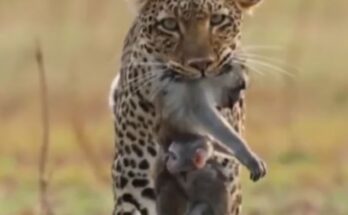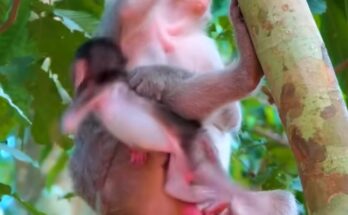In the heart of a dense tropical forest, a compelling drama unfolds high above the ground, among the tangle of branches and vines. A baby monkey, still unsteady in its early explorations, has found itself in a dangerous predicament. Caught between two narrow branches with limited footing and surrounded by sheer drops, the young primate is visibly frightened and immobile. Above and around, the sounds of the forest go on uninterrupted — birds call, insects buzz, and leaves rustle in the wind — but for this small family, time seems to stand still.
The mother monkey, alert and visibly distressed, circles her baby from various angles, trying to find a path that will bring her close enough to help. Her actions are methodical yet frantic, marked by quick decisions and emotional urgency. Each attempt is met with either a break in the branches or a risky reach that could endanger both herself and her young. The scene is a striking reminder of the deep instincts and emotional capacities of animals, especially in their roles as caregivers and protectors.
Primates, like humans, are known for their intelligence and strong social bonds. The maternal relationship, in particular, is crucial for survival and development. The mother monkey’s persistence is more than just instinct—it is a display of love, attachment, and resilience. She makes repeated attempts to reach the baby, using her limbs with surprising dexterity, testing each branch’s strength before stepping onto it. Her face shows a mix of concentration and concern as she vocalizes softly, likely to soothe her baby and signal her presence.
Meanwhile, the baby monkey clings tightly to the small branch beneath it, its body trembling. It doesn’t cry out, perhaps instinctively aware that loud noises might attract predators. Instead, it waits, trusting in its mother’s eventual rescue. The scene is tense, but also filled with an unspoken hope — a quiet understanding between the two that help is coming.
After what feels like an eternity, the mother finds a path by swinging underneath the baby’s position, using a series of vines to anchor herself. With careful timing and a burst of agile strength, she reaches up and gently grabs her baby’s arm, pulling it slowly toward her chest. There is a moment of resistance as the baby struggles to move, but with a final pull, the mother secures her child and climbs back to safer ground.
This small yet powerful moment reveals much about the emotional lives of animals. It is a testament to maternal determination and the deep-seated instinct to protect and nurture. In the wild, every action counts, and every decision carries the weight of survival. But beyond survival, there is something undeniably touching about the scene — a mother, risking everything to bring her baby to safety.
Ultimately, this story is more than just a snapshot of animal behavior; it is a mirror reflecting the universality of care, courage, and connection. Whether in a forest canopy or a human home, the bond between parent and child transcends species — and moments like these remind us just how alike we truly are.


